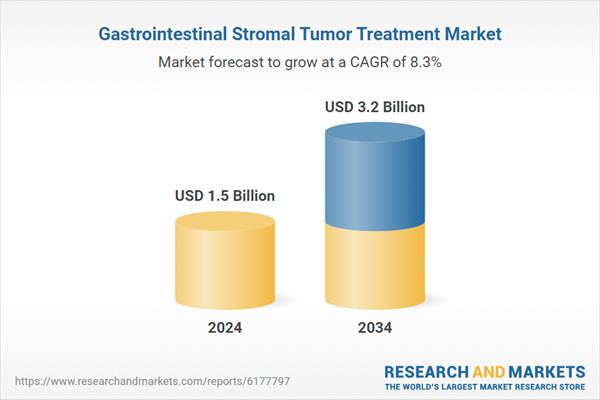This growth can be attributed to the increasing global prevalence of gastrointestinal cancers and heightened awareness of rare tumor types. Advancements in targeted therapies, particularly tyrosine kinase inhibitors (TKIs), are improving treatment outcomes and survival rates significantly. The rising incidence of metastatic and treatment-resistant GIST cases has further fueled demand for innovative drugs like ripretinib, avapritinib, and regorafenib, which are used to manage disease progression and enhance patient quality of life at various stages of the condition. Treatments for GIST are typically administered orally and are available through hospital pharmacies, retail pharmacies, and online platforms. These therapies include categories such as tyrosine kinase inhibitors, multikinase inhibitors, and combination treatments, all aimed at both primary and metastatic tumors. The market is populated by numerous global pharmaceutical companies that continue to invest heavily in research and development, resulting in the approval of new therapies and expanded treatment indications. The introduction of precision oncology and mutation-specific treatments is reshaping the market, with drugs tailored to specific genetic mutations demonstrating higher efficacy and fewer side effects.
In 2024, the tyrosine kinase inhibitors segment held a share of 62.3% in the GIST treatment market, driven by their targeted action and proven clinical effectiveness. As personalized medicine becomes more prevalent, the demand for tyrosine kinase inhibitors has surged. These drugs, particularly imatinib, are considered the standard first-line treatment for metastatic GIST and continue to be preferred due to their high efficacy, as noted by research from the National Institutes of Health (NIH).
The branded drug segment will grow at a CAGR of 8.1% through 2034. Branded therapies are favored due to their demonstrated clinical success, FDA approvals, and consistent inclusion in global treatment guidelines. These treatments target specific genetic mutations like KIT and PDGFRA, which are commonly found in GIST patients. Ongoing investments in research and development are driving the creation of next-generation tyrosine kinase inhibitors (TKIs) and combination therapies designed to overcome drug resistance and improve treatment outcomes.
United States Gastrointestinal Stromal Tumor Treatment Market was valued at USD 561.8 million in 2024, reflecting significant demand. With the advancement of diagnostic imaging and molecular testing, more GIST cases are being accurately detected in the U.S., leading to an increased number of patients seeking treatment. Additionally, supportive FDA regulations and reimbursement policies are facilitating the approval and adoption of both branded and generic treatments, further expanding market opportunities.
Major players in the Gastrointestinal Stromal Tumor Treatment Market include Bayer, Pfizer, Takeda Pharmaceuticals, F. Hoffmann-La Roche, Novartis, Sun Pharma, Shorla Oncology, Glenmark, AngioDynamics, Argon Medical Products, Natco Pharma, and Deciphera Pharma. To strengthen their position in the gastrointestinal stromal tumor treatment market, companies are focusing on several key strategies. This includes heavy investment in research and development (R&D) to bring innovative treatments to market and expand existing product lines. Many companies are prioritizing the development of next-generation tyrosine kinase inhibitors and combination therapies, particularly those targeting resistance mechanisms. Additionally, companies are enhancing their market foothold by forming strategic partnerships with research institutions and other pharmaceutical companies to accelerate drug development and broaden distribution networks. Strengthening brand equity through long-term clinical trial data, FDA approvals, and integration into global treatment guidelines is also a critical focus. Finally, companies are expanding their geographical reach and increasing access to treatments in emerging markets, where the incidence of GIST is rising, thereby maximizing growth potential.
Comprehensive Market Analysis and Forecast
- Industry trends, key growth drivers, challenges, future opportunities, and regulatory landscape
- Competitive landscape with Porter’s Five Forces and PESTEL analysis
- Market size, segmentation, and regional forecasts
- In-depth company profiles, business strategies, financial insights, and SWOT analysis
This product will be delivered within 2-4 business days.
Table of Contents
Companies Mentioned
The companies profiled in this Gastrointestinal Stromal Tumor Treatment market report include:- Bayer
- Deciphera Pharmaceuticals
- F. Hoffmann-La Roche
- Glenmark
- Natco Pharma
- Novartis
- Pfizer
- Sanofi
- Shorla Oncology
- Sun Pharmaceuticals
- Takeda Pharmaceuticals
Table Information
| Report Attribute | Details |
|---|---|
| No. of Pages | 135 |
| Published | September 2025 |
| Forecast Period | 2024 - 2034 |
| Estimated Market Value ( USD | $ 1.5 Billion |
| Forecasted Market Value ( USD | $ 3.2 Billion |
| Compound Annual Growth Rate | 8.3% |
| Regions Covered | Global |
| No. of Companies Mentioned | 12 |









